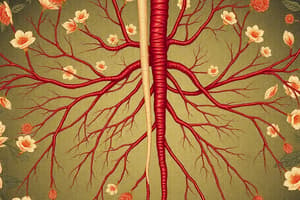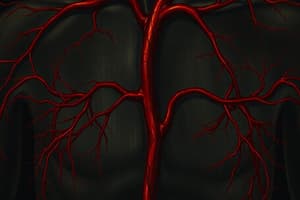Podcast
Questions and Answers
Which characteristic distinguishes a closed circulatory system from an open circulatory system?
Which characteristic distinguishes a closed circulatory system from an open circulatory system?
- The presence of a heart.
- The direct bathing of tissues in blood.
- Blood circulating entirely within blood vessels. (correct)
- The absence of a circulatory fluid.
In organisms with a closed circulatory system, which of the following is a primary advantage?
In organisms with a closed circulatory system, which of the following is a primary advantage?
- Less need for energy.
- Lower metabolic rates.
- Lower blood pressure.
- Efficient nutrient and gas exchange. (correct)
Which type of animal is LEAST likely to have a closed circulatory system?
Which type of animal is LEAST likely to have a closed circulatory system?
- Arthropods like insects (correct)
- Cephalopods like squids
- Vertebrates like mammals
- Annelid worms
Which of the following statements accurately describes the function of valves in the heart?
Which of the following statements accurately describes the function of valves in the heart?
Which of the following is the primary role of arteries within the circulatory system?
Which of the following is the primary role of arteries within the circulatory system?
Which of the following best describes the function of capillaries in the circulatory system?
Which of the following best describes the function of capillaries in the circulatory system?
What is the function of veins in the circulatory system?
What is the function of veins in the circulatory system?
In a four-chambered heart, what is the primary destination of blood pumped from the right ventricle?
In a four-chambered heart, what is the primary destination of blood pumped from the right ventricle?
In the systemic circuit, which heart chamber receives oxygenated blood from the lungs?
In the systemic circuit, which heart chamber receives oxygenated blood from the lungs?
Which component of blood is primarily responsible for defending against infection and disease?
Which component of blood is primarily responsible for defending against infection and disease?
Which component of the blood plays a critical role in blood clotting and wound healing?
Which component of the blood plays a critical role in blood clotting and wound healing?
What is the main function of red blood cells?
What is the main function of red blood cells?
Which blood component is primarily composed of water and contains proteins, nutrients, gases, and hormones?
Which blood component is primarily composed of water and contains proteins, nutrients, gases, and hormones?
During blood flow through the heart, which valve does blood pass through after leaving the right atrium?
During blood flow through the heart, which valve does blood pass through after leaving the right atrium?
After passing through the bicuspid (mitral) valve, where does blood flow next?
After passing through the bicuspid (mitral) valve, where does blood flow next?
Which of the following represents the correct sequence of blood flow after blood leaves the lungs?
Which of the following represents the correct sequence of blood flow after blood leaves the lungs?
After blood passes through the aortic valve, where does it flow next?
After blood passes through the aortic valve, where does it flow next?
After travelling through the vena cava, what is the next destination for deoxygenated blood?
After travelling through the vena cava, what is the next destination for deoxygenated blood?
What is the primary role of albumin in blood plasma?
What is the primary role of albumin in blood plasma?
Which type of vertebrate has a heart with two atria and a ventricle, resulting in some mixing of oxygenated and deoxygenated blood?
Which type of vertebrate has a heart with two atria and a ventricle, resulting in some mixing of oxygenated and deoxygenated blood?
Flashcards
Circulatory System
Circulatory System
Distributes nutrients, gases, hormones, and waste. Includes the heart, blood vessels, and blood.
Open Circulatory System
Open Circulatory System
Blood (hemolymph) is pumped into open spaces (sinuses) and directly bathes tissues.
Closed Circulatory System
Closed Circulatory System
Blood circulates entirely within blood vessels.
Examples of Closed Circulatory Systems
Examples of Closed Circulatory Systems
Signup and view all the flashcards
Definition of Closed Circulatory system
Definition of Closed Circulatory system
Signup and view all the flashcards
Definition of Open Circulatory System
Definition of Open Circulatory System
Signup and view all the flashcards
Circulatory Fluid: Closed System
Circulatory Fluid: Closed System
Signup and view all the flashcards
Circulatory Fluid: Open System
Circulatory Fluid: Open System
Signup and view all the flashcards
Closed Systems and Metabolic Rates
Closed Systems and Metabolic Rates
Signup and view all the flashcards
Heart: Mammals and Birds
Heart: Mammals and Birds
Signup and view all the flashcards
Right Side of Heart (Mammals/Birds)
Right Side of Heart (Mammals/Birds)
Signup and view all the flashcards
Valves (Tricuspid, Bicuspid, Aortic, Pulmonary)
Valves (Tricuspid, Bicuspid, Aortic, Pulmonary)
Signup and view all the flashcards
Arteries
Arteries
Signup and view all the flashcards
Capillaries
Capillaries
Signup and view all the flashcards
Veins
Veins
Signup and view all the flashcards
Plasma
Plasma
Signup and view all the flashcards
Plasma Proteins
Plasma Proteins
Signup and view all the flashcards
Formed Elements
Formed Elements
Signup and view all the flashcards
Red Blood Cells (Erythrocytes)
Red Blood Cells (Erythrocytes)
Signup and view all the flashcards
White Blood Cells (Leukocytes)
White Blood Cells (Leukocytes)
Signup and view all the flashcards
Study Notes
- The circulatory system distributes nutrients, gases, hormones, and waste products.
- It is composed of the heart, blood vessels, and blood.
- It helps with thermoregulation, immunity, and pH balance.
Open Circulatory System
- Found in invertebrates, such as arthropods and most mollusks.
- Hemolymph is pumped into sinuses and directly bathes the tissues.
Closed Circulatory System
- Present in annelids, cephalopods, and all vertebrates.
- Blood circulates entirely within blood vessels allowing efficient nutrient and gas exchange.
Comparison of Open and Closed Circulatory Systems
- Open circulatory systems have blood pumped into open body cavities, unlike closed systems.
- Open systems have hemolymph as the circulatory fluid, versus blood in closed systems.
- Open systems have heart-like structures, sinuses, and hemocoel, contrasting with the heart and blood vessels in closed ones.
- Pressure is low in open systems but high in closed ones.
- Open circulatory systems are less efficient and suitable for smaller, slower animals.
- Closed circulatory systems are more efficient for larger and active animals.
- Arthropods and mollusks have open systems versus vertebrates and cephalopods with closed systems.
High Metabolic Rates
- Closed circulatory systems support high metabolic rates required by animals with greater energy demands, like mammals and birds.
Heart Structure and Blood Flow
- Mammals and birds have a four-chambered heart, with two atria and two ventricles.
- The right side of the heart pumps deoxygenated blood to the lungs via the pulmonary circuit.
- The left side pumps oxygenated blood to the body via the systemic circuit.
- Valves (tricuspid, bicuspid, aortic, pulmonary) maintain unidirectional blood flow.
Comparative Anatomy of Vertebrate Circulation
- Fish have a heart with 2 chambers (1 atrium, 1 ventricle) and single circulation, so blood passes through the heart once per cycle.
- Amphibians possess a 3-chambered heart (2 atria, 1 ventricle) and double circulation where some mixing of oxygenated and deoxygenated blood occurs.
- Reptiles have a 3.5-chambered heart (partial septum) and double circulation with improved separation of oxygenated blood.
- Birds and mammals have a 4-chambered heart (2 atria, 2 ventricles) and full double circulation.
- Full double circulation allows for complete separation of oxygenated and deoxygenated blood.
Blood Vessels
- Arteries carry blood away from the heart and have thick muscular walls for high pressure.
- Capillaries are thin-walled vessels where the exchange of gases, nutrients, and waste occurs.
- Veins return blood to the heart and contain valves to prevent backflow.
Pathway of Blood Flow
- Deoxygenated blood flows from the body to the vena cava.
- Blood moves from the right atrium, through the tricuspid valve, to the right ventricle.
- Blood is then pumped through the pulmonary valve to the pulmonary artery and then to the lungs.
- Oxygenated blood returns from the lungs to the pulmonary veins.
- Blood flows from the left atrium, through the bicuspid (mitral) valve, to the left ventricle.
- Finally, blood exits the left ventricle through the aortic valve to the aorta and then to the body.
Memory trick
- "RA → LA via foramen ovale, and PA → aorta via ductus arteriosus."
Components of Blood
- Plasma makes up 55% of total blood volume and is a water-based solution containing proteins, nutrients, gases, and hormones.
- Water (90-92%) in plasma acts as a solvent and transporter.
- Plasma proteins (about 7%) include albumin, globulins, and fibrinogen.
- Albumin maintains osmotic pressure.
- Globulins are antibodies and transport proteins.
- Fibrinogen is involved in blood clotting.
- Solutes (1-2%) in plasma include ions (Na+, K+, Ca+), nutrients (glucose, amino acids), hormones, wastes, and gases (O2, CO2).
- Formed elements make up 45% of blood.
- Red blood cells (erythrocytes) transport oxygen using hemoglobin.
- White blood cells (leukocytes) defend against infection and disease.
- Platelets (thrombocytes) contribute to blood clotting and wound healing.
Studying That Suits You
Use AI to generate personalized quizzes and flashcards to suit your learning preferences.




